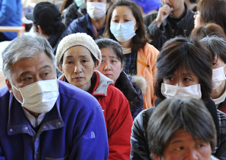3Qs: Surviving the trauma in Japan

Following last month’s severe earthquake, Japan has endured two strong aftershocks in less than a week, knocking out power in some areas and undoubtedly intensifying the anxieties of residents. Here, Hortensia Amaro, Distinguished Professor and associate dean in Bouvé College of Health Sciences, discusses the role post-traumatic stress disorder (PTSD) may be playing in the lives of the Japanese people today.
What are the criteria for a diagnosis of PTSD?
There are six criteria specified in the Diagnostic and Statistical Manual of Mental Disorders. First, you have to be exposed to a traumatic event that involves the threat of death or serious injury, or a threat to the physical well-being of others. Second, you re-experience the traumatic event through recurrent and distressing recollections, frightening dreams or intense distress in response to cues that remind you of the event. Third, you avoid thoughts, places and people associated with the event, and your general responsiveness seems numbed. Fourth, you exhibit symptoms of increased arousal, such as sleep difficulties, irritability, problems with concentrating, hypervigilance or an exaggerated startle response. Fifth, the symptoms last for more than a month. And sixth, the symptoms cause you clinically significant distress or impairment in your daily life.
Given the recent catastrophes in Japan, are its inhabitants likely to experience PTSD? Could these tragedies cause PTSD in people in other parts of the world, too?
People who lived through the earthquake in Japan could certainly experience PTSD, although not all individuals in Japan will meet the criteria. From previous research, we know that disaster survivors are quite likely to experience psychological problems as well as declines in their physical health, including a greater vulnerability to cardiovascular disease.
The extent to which the people of Japan will experience PTSD depends on many factors: the directness of their exposure to the event, their degree of loss, their previous personality and psychiatric profile, and the capacity of the government and other entities to stabilize daily-life activities and ensure a sense of safety.
Studies have shown that women, children, the elderly, the poor and those with previous mental-health problems are at a higher risk of experiencing more-serious symptoms and perhaps longer-term effects.
The worldwide impact is difficult to predict and assess. People who have had similar disaster experiences might be most vulnerable, especially those who continue to experience PTSD. Those who live close to the event or in settings at high risk for similar events might be vulnerable, too.
How might PTSD caused by the tragedies in Japan be treated?
There is no evidence-based consensus on the effectiveness of interventions in the immediate and midterm post-trauma phases of a massive disaster like this.
However, there are some agreed-upon principles that health authorities follow: Promote a sense of safety. Promote calming. Promote self-efficacy and collective efficacy. Promote a sense of connectedness. And instill hope.
These principles suggest what the Japanese government needs to do, both in its messages and in the services it provides: Ease stress. Build connectedness and hope. And refocus people’s attention on normalcy rather than on the tragedy.





